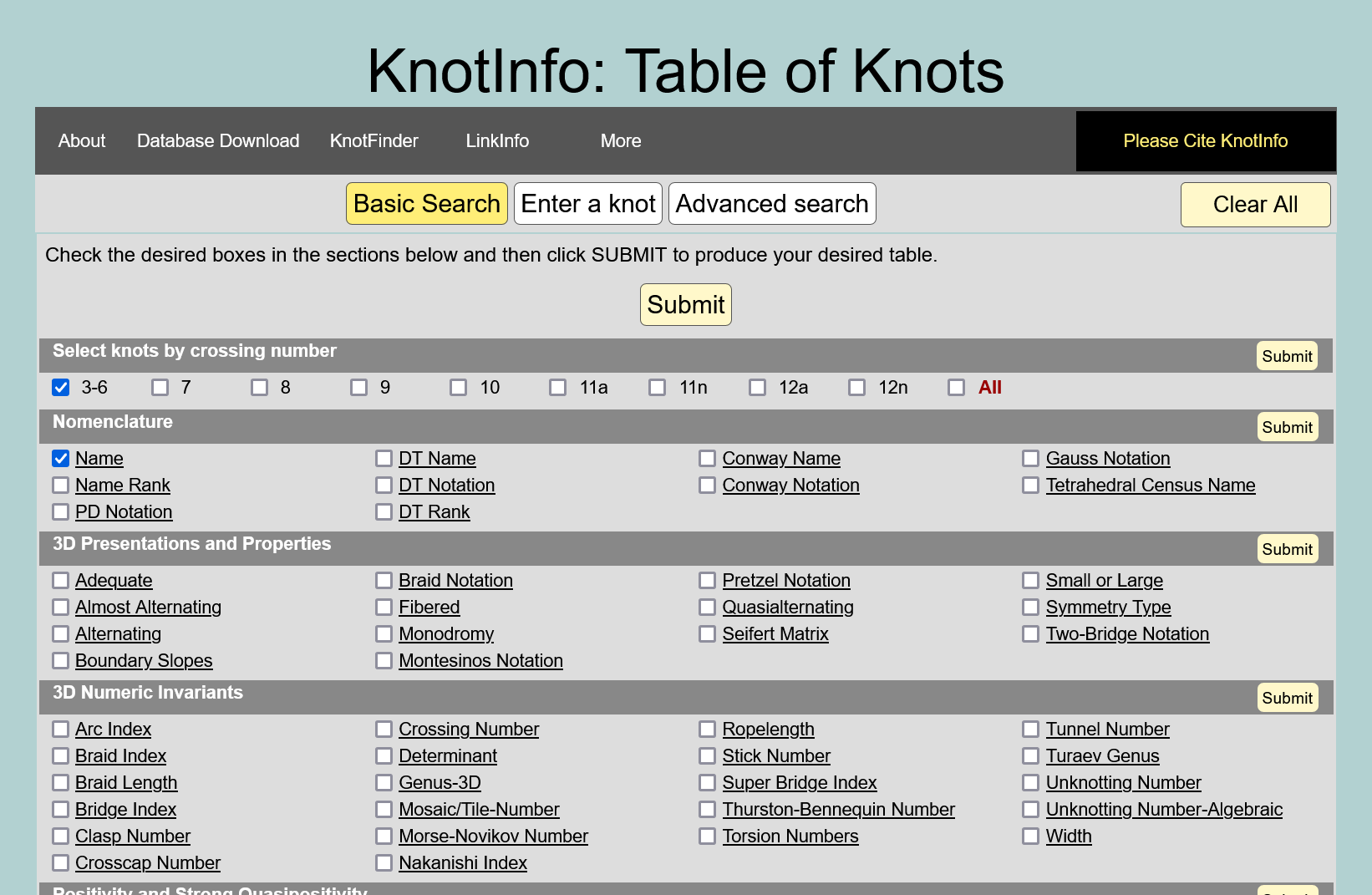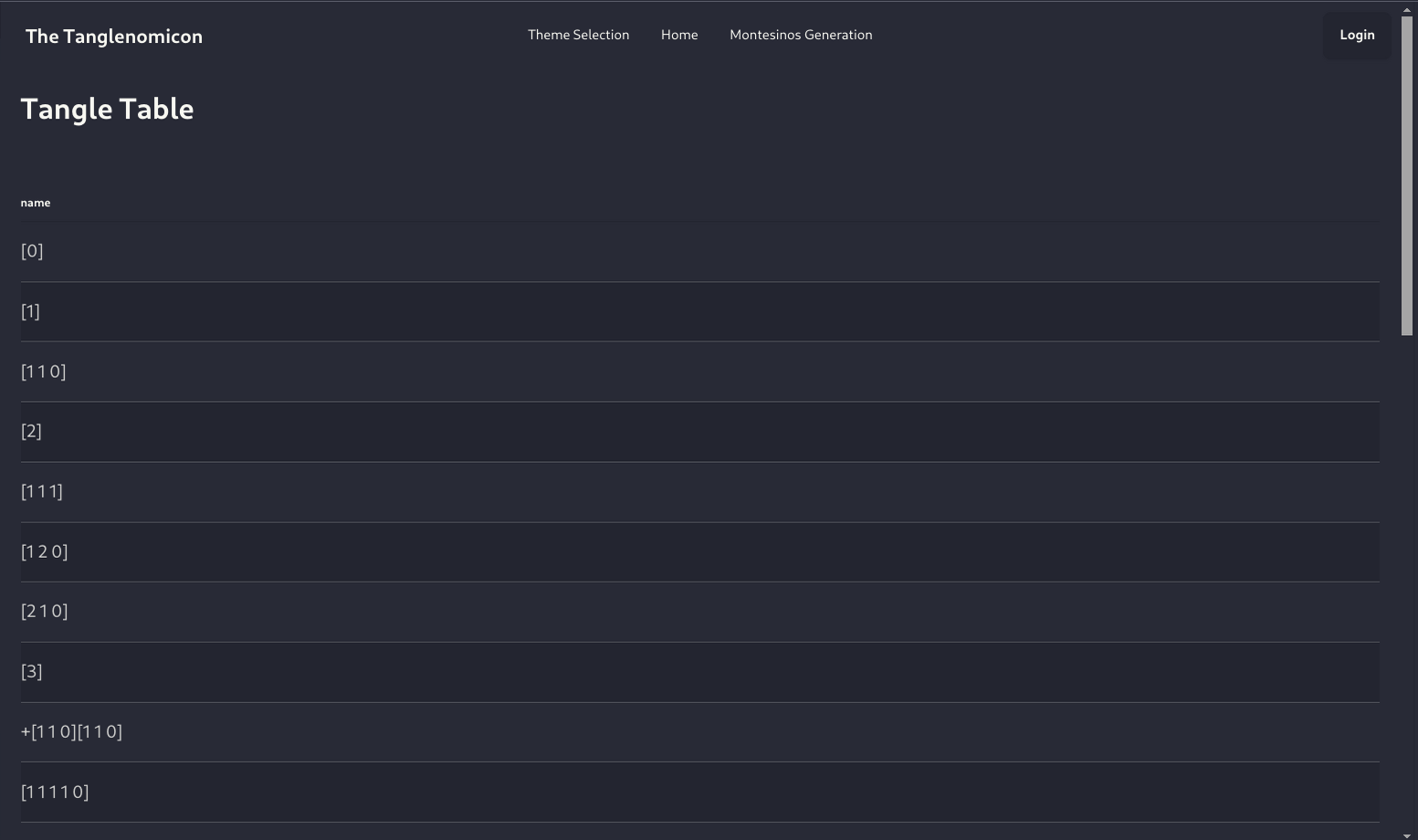$\newcommand{\N}{\mathbb{N}} \newcommand{\Z}{\mathbb{Z}} \newcommand{\Q}{\mathbb{Q}} \newcommand{\R}{\mathbb{R}} \newcommand{\LP}{\left(} \newcommand{\RP}{\right)} \newcommand{\LS}{\left\lbrace} \newcommand{\RS}{\right\rbrace} \newcommand{\LA}{\left\langle} \newcommand{\RA}{\right\rangle} \newcommand{\LB}{\left[} \newcommand{\RB}{\right]} \newcommand{\MM}{\ \middle|\ } \newcommand{\exp}{\text{exp}} \newcommand{\abs}[1]{\left\vert#1\right\vert} \newcommand{\msr}[1]{m\left(#1\right)} \newcommand{\inv}[1]{#1^{-1}} \newcommand{\bkt}[1]{\LA \img{#1}\RA} \require{color}$
Comprehensive Exam (8/19/24)
The Tanglenomicon
Zachary Bryhtan, Nicholas Connolly, Isabel Darcy, Ethan Rooke, Joseph Starr*
Mathematics Department at The University of Iowa
Knots
The natural question
How many knots?
Knot Tables
Lord Kelvin’s vortex theory of the atom

By Hand
- 1860’s Tait computes knots up to 7 crossings
- 15 knots
- 1870’s Tait, Kirkman, and Little compute knots up to 10 crossings
- Takes about 25 years
- 250 knots
- 1960’s Conway computes knots up to 11 crossings
- “A few hours”
- 802 knots
By Computer
- 1980’s Dowker and Thistlethwaite compute up to 13 crossings
- First using a computer
- 12,966 knots
- 1990’s Hoste, Thistlethwaite, and Weeks compute up to 16 crossings
- Computer runtime on the order of weeks
- 1,701,936 knots
- 2020’s Burton computes up to 19 crossings
- 350 Million knots
KnotInfo

C. Livingston and A. H. Moore, KnotInfo: Table of Knot Invariants, https://knotinfo.math.indiana.edu/, today’s date (eg. August 24, 2023)
Conway
Tangles
“We define a tangle as a portion of a knot diagram from which there emerge just 4 arcs pointing in the compass directions NW, NE, SW, SE.” - Conway, J.H.
Conway, J.H. “An Enumeration of Knots and Links, and Some of Their Algebraic Properties.” In Computational Problems in Abstract Algebra, 329-58. Elsevier, 1970. https://doi.org/10.1016/B978-0-08-012975-4.50034-5
Basic Operations
Operation $+$
Operation $\vee$
The Tanglenomicon
A table of two string tangles
(up to fixed boundary)
Building up
Where we are
Rational Tangles
Generation
For any $N$ an obvious twist vector is the twist vector of all $1$s $$[1\ 1\ 1\ \cdots\ 1]$$ Noting that when we write this sequence, we have $N-1$ spaces.
If we choose to place a $+$ instead of the left most space we get $$[1+1\ 1\ \cdots\ 1]=[2\ 1\ \cdots\ 1]$$ we’re free to make this choice for each space
this gives $N-1$ choices between ‘$+$’ and space $$[1\square 1\square 1\square\cdots\square1]$$ letting us generate twist vectors by simply counting from $0\to 2^{N-1}$.
Programmatic Description
| i | tmplt | cnt | j | tv |
|---|---|---|---|---|
| 0 | 0000 | 5 | 0 | [1,1,1,1,1] |
| 0 | 0000 | 4 | 1 | [1,1,1,1,1] |
| 0 | 0000 | 3 | 2 | [1,1,1,1,1] |
| 0 | 0000 | 2 | 3 | [1,1,1,1,1] |
| 0 | 0000 | 1 | 4 | [1,1,1,1,1] |
| 0 | 0000 | 0 | 4 | [1,1,1,1,1] |
| i | tmplt | cnt | j | tv |
|---|---|---|---|---|
| 6 | 0110 | 5 | 4 | [1,1,1,1,1] |
| 6 | 0011 | 4 | 1 | [1,1,1,1,1] |
| 6 | 0001 | 3 | 1 | [1,2,1,1,1] |
| 6 | 0000 | 2 | 1 | [1,3,1,1,1] |
| 6 | 0000 | 1 | 2 | [1,3,1,1,1] |
| 6 | 0000 | 0 | 2 | [1,3,1,1,1] |
| i | tmplt | cnt | j | tv |
|---|---|---|---|---|
| 7 | 0111 | 5 | 0 | [1,1,1,1,1] |
| 7 | 0011 | 4 | 0 | [2,1,1,1,1] |
| 7 | 0001 | 3 | 0 | [3,1,1,1,1] |
| 7 | 0000 | 2 | 0 | [4,1,1,1,1] |
| 7 | 0000 | 1 | 1 | [4,1,1,1,1] |
| 7 | 0000 | 0 | 1 | [4,1,1,1,1] |
Canonical Twist Vectors
We can write a canonical twist vector by taking the odd length vectors (appending $0$ where needed).
Computations
Rational Number (continued fraction)
The rational number for a twist vector is computed by taking the twist vector as a finite continued fraction, that is: $$\LB a\ b\ c\RB=c+\frac{1}{b+\frac{1}{a}}$$
- J.R. Goldman, L.H. Kauffman, Rational Tangles, Advances in Applied Math., 18 (1997), 300-332.
- Conway, J.H. “An Enumeration of Knots and Links, and Some of Their Algebraic Properties.” In Computational Problems in Abstract Algebra, 329-58. Elsevier, 1970. https://doi.org/10.1016/B978-0-08-012975-4.50034-5
To play with twist vectors and continued fractions, visit:
https://joe-starr.com/resources/cont_frac_convert/
Parity
Computing Parity
If we take the rational number $\frac{p}{q}$ associated with the rational tangle we get the following correspondence for parity
Louis H. Kauffman and Sofia Lambropoulou. Classifying and applying rational knots and rational tangles. In DeTurck, editor, Contemporary Mathematics, volume 304, pages 223-259, 2001
Closures
Closure Equivalence and pivoting to knots
(1) $p=p^{\prime}$
(2) either $q \equiv q^{\prime}(\bmod p)$ or $q q^{\prime} \equiv 1(\bmod p)$.
Schubert, Horst. “Knoten mit zwei Brücken..” Mathematische Zeitschrift 65 (1956): 133-170. http://eudml.org/doc/169591.
Montesinos
Existence of canonical diagrams for Montesinos tangles
F. Bonahon and L. Siebenmann, New geometric splittings of classical knots, and the classification and symmetries of arborescent knots, http://www-bcf.usc.edu/~fbonahon/Research/Publications.html
Generation
For Montesinos tangles of crossing number $N$ we start by again generating twist vectors, however we require that each entry $e$ of the twist vector satisfies $2\leq e < N.$
We call these restricted set of twist vectors stencils.
Now for each entry $e_i$ of the stencil, we generate a list of rational tangles of crossing number equal to $e_i$, with the restriction $0<\frac{p_i}{q_i}<1$. We then take all combinations of elements of these lists.
What about the ‘k’?
The construction for the canonical Montesinos tangles includes a trailing $\frac{k}{1}$ tangle. Our generation strategy seems to miss these.
What we’re actually generating with this algorithm is Montesinos tangles up to moveable boundary components of the tangle. To recover fixed boundary tangles we can append an integral $k$ summand to each lower crossing Montesinos tangle with a circle product (more to come).
Programmatic Description
Using The Tanglenomicon
Alpha


To play with a live version, visit:
https://tanglenomicon.com
Where we’re going
Generalized Montesinos
Operation $\circ$
Moon, Hyeyoung, and Isabel K. Darcy. “Tangle Equations Involving Montesinos Links.” Journal of Knot Theory and Its Ramifications 30, no. 08 (July 2021): 2150060. https://doi.org/10.1142/S0218216521500607.
Generation
We just need to take our lists of Montesinos and rational tangles and glue them together with $\circ$.
Algebraic
All possible tangles made from $+$ and $\vee$ on basic tangles
Generation
A tale of two strate-trees
strate-tree 1
Algebraic Tangle Trees
As we saw, we can linearize any algebraic tangle as:
$$\LP\LB3\ 2\ 3\RB+\LB3\ 2\ 3\RB\RP\vee\LP\LB3\ 2\ 3\RB+\LB3\ 2\ 3\RB\RP$$
How do we programmatically generate tangles from this?
$$\LP\LB3\ 2\ 3\RB+\LB3\ 2\ 3\RB\RP\vee\LP\LB3\ 2\ 3\RB+\LB3\ 2\ 3\RB\RP$$
We can generate all possible algebraic expressions involving the basic tangles and twist vector of rational tangles.
Equivalently, all full binary trees with $N$ leaves. Where the tree’s internal nodes are labeled with combinations of $\vee$ and $+$ and leaves are labeled with all combinations of basic tangles or the twist vector of rational tangles.
We call these binary trees Algebraic Tangle Trees.
- Alain Caudron. Classification des nœuds et des enlacements, volume 4 of Publications Math ́ematiques d’Orsay 82 [Mathematical Publications of Orsay 82]. Universit ́e de ParisSud, D ́epartement de Mathe ́matique, Orsay, 1982.
- Connolly, Nicholas. Classification and Tabulation of 2-String Tangles: The Astronomy of Subtangle Decompositions. University of Iowa, 2021, https://doi.org/10.17077/etd.005978.
A problem
strate-tree 2
Arborescent Tangles
Bonahon and Siebenmann describe a classification for what they call Arborescent Tangles. Their Arborescent Tangles can be translated into our algebraic tangles.
These Arborescent Tangles are constructed by taking a collection of twisted bands described by a weighted tree and connecting them with successive Murasugi sums.
F. Bonahon and L. Siebenmann, New geometric splittings of classical knots, and the classification and symmetries of arborescent knots, http://www-bcf.usc.edu/~fbonahon/Research/Publications.html
Arborescent Tangles
Generation
???
Into the future
Non-algebraic/Polygonal
4-valent planar graphs
4-valent planar graph insertions
Generation
There exist tables of 4 valent graphs. We can use those with insertions from our list of algebraic tangles to generate all polygonal tangles.
Tooling
Design Goals
The design for The Tanglenomicon project prioritizes flexibility and extensibility. We want a feature, maybe “calculate Jones polynomial,” to be runnable in a jupyter notebook or on a university cluster. We’re aiming for a “write once deploy anywhere” design.
To that end we’ve decoupled functionality wherever feasible, taking a layered approach for system design.
Runners
A runner is a human/machine interface layer. This abstracts the routines in lower layers for a user to interact with. This could be a CLI, Python binding, a Mathematica wrapper, or a web API.
Runnables
Generators
Generators create new data. A generator might look like a module to create rational tangles. They may use one or more Computations, Notations, or Translators.
Computation
Computations compute a value for a given data. A computation might look like a module for computing a Jones polynomial of a link, or computing the writhe of a tangle.
Translators
Translators define a conversion between two Notations. A translator might look like a module for converting from PD notation to Conway notation and back again.
Data Wranglers
Notations
Notations define a notational convention for a link/tangle. They describe a method for converting to and from a string representation of a link/tangle and data structure describing that link/tangle.
Storage
A storage module defines a storage interface for the application. The main inter-module type is string and the calling module is responsible for en/decoding the string with a notation module.
core libraries
-------------------------------------------------------------------------------
Language files blank comment code
-------------------------------------------------------------------------------
C 13 516 834 3563
C/C++ Header 18 408 967 1939
C++ 7 107 222 912
Markdown 21 418 0 794
SVG 5 5 5 322
CMake 41 74 21 236
TeX 1 1 0 92
Cython 1 21 2 83
JSON 2 1 0 78
Python 3 37 79 68
YAML 3 17 9 64
Nix 1 17 56 38
Text 1 0 0 7
-------------------------------------------------------------------------------
SUM: 117 1622 2195 8196
-------------------------------------------------------------------------------
Web API
┏━━━━━━━━━━━━━━━┳━━━━━━━┳━━━━━━━┳━━━━━━┳━━━━━━┳━━━━━━━━━┳━━━━━━┓
┃ Language ┃ Files ┃ % ┃ Code ┃ % ┃ Comment ┃ % ┃
┡━━━━━━━━━━━━━━━╇━━━━━━━╇━━━━━━━╇━━━━━━╇━━━━━━╇━━━━━━━━━╇━━━━━━┩
│ Python │ 27 │ 30.7 │ 1818 │ 53.9 │ 766 │ 22.7 │
│ Markdown │ 56 │ 63.6 │ 1473 │ 34.1 │ 0 │ 0.0 │
│ YAML │ 4 │ 4.5 │ 89 │ 93.7 │ 6 │ 6.3 │
│ __duplicate__ │ 1 │ 1.1 │ 0 │ 0.0 │ 0 │ 0.0 │
├───────────────┼───────┼───────┼──────┼──────┼─────────┼──────┤
│ Sum │ 88 │ 100.0 │ 3380 │ 43.4 │ 772 │ 9.9 │
└───────────────┴───────┴───────┴──────┴──────┴─────────┴──────┘
Web frontend
| language | files | code | comment | blank | total |
|----------------------|-------|-------|---------|-------|-------|
| JSON | 2 | 3,119 | 0 | 2 | 3,121 |
| SVG | 1 | 1,489 | 1 | 2 | 1,492 |
| JavaScript JSX | 6 | 398 | 9 | 43 | 450 |
| source.markdown.math | 2 | 161 | 0 | 62 | 223 |
| TypeScript JSX | 2 | 143 | 1 | 13 | 157 |
| JavaScript | 7 | 141 | 2 | 14 | 157 |
| XML | 5 | 56 | 0 | 0 | 56 |
| JSON with Comments | 1 | 37 | 0 | 1 | 38 |
| TypeScript | 1 | 20 | 0 | 4 | 24 |
| CSS | 3 | 18 | 0 | 4 | 22 |
| Nix | 1 | 16 | 0 | 3 | 19 |
| HTML | 1 | 13 | 0 | 1 | 14 |
| Docker | 1 | 12 | 1 | 11 | 24 |
| Properties | 1 | 9 | 1 | 2 | 12 |
Technologies
Sources
- Dror Bar-Natan The Most Important Missing Infrastructure Project in Knot Theory
- Kauffman, L. H., and S. Lambropoulou. “From Tangle Fractions to DNA.” In Topology in Molecular Biology, edited by Michail Ilych Monastyrsky, 69-110. Biological and Medical Physics, Biomedical Engineering. Berlin, Heidelberg: Springer Berlin Heidelberg, 2007. https://doi.org/10.1007/978-3-540-49858-2_5.
- Moon, Hyeyoung, and Isabel K. Darcy. “Tangle Equations Involving Montesinos Links.” Journal of Knot Theory and Its Ramifications 30, no. 08 (July 2021): 2150060. https://doi.org/10.1142/S0218216521500607.
- Conway, J.H. “An Enumeration of Knots and Links, and Some of Their Algebraic Properties.” In Computational Problems in Abstract Algebra, 329-58. Elsevier, 1970. https://doi.org/10.1016/B978-0-08-012975-4.50034-5.
- Louis H. Kauffman and Sofia Lambropoulou. Classifying and applying rational knots and rational tangles. In DeTurck, editor, Contemporary Mathematics, volume 304, pages 223-259, 2001
- Alain Caudron. Classification des nœuds et des enlacements, volume 4 of Publications Math ́ematiques d’Orsay 82 [Mathematical Publications of Orsay 82]. Universit ́e de ParisSud, D ́epartement de Mathe ́matique, Orsay, 1982.
- Robert Glenn Scharein. Interactive topological drawing. ProQuest LLC, Ann Arbor, MI, 1998. Thesis (Ph.D. The University of British Columbia (Canada). URL: https://www.knotplot.com/.
- Jablan, S., & Sazdanović, R. (2007). Linknot. In Series on Knots and Everything. WORLD SCIENTIFIC. https://doi.org/10.1142/6623
- Dowker, C. H., & Thistlethwaite, M. B. (1983). Classification of knot projections. In Topology and its Applications (Vol. 16, Issue 1, pp. 19-31). Elsevier BV. https://doi.org/10.1016/0166-8641(83)90004-4
- Hoste, J., Thistlethwaite, M., & Weeks, J. (1998). The first 1,701,936 knots. In The Mathematical Intelligencer (Vol. 20, Issue 4, pp. 33-48). Springer Science and Business Media LLC. https://doi.org/10.1007/bf03025227
- Burton, B. A. (2020). The Next 350 Million Knots. Schloss Dagstuhl - Leibniz-Zentrum Für Informatik. https://doi.org/10.4230/LIPICS.SOCG.2020.25
- C. Livingston and A. H. Moore, KnotInfo: Table of Knot Invariants, knotinfo.math.indiana.edu, today’s date (eg. August 24, 2023).
- Schubert, Horst. “Knoten mit zwei Brücken..” Mathematische Zeitschrift 65 (1956): 133-170. http://eudml.org/doc/169591.
- Jos ́e M. Montesinos. Seifert manifolds that are ramified two-sheeted cyclic coverings. Bol. Soc. Mat. Mexicana (2), 18:1-32, 1973.
- F. Bonahon and L. Siebenmann, New geometric splittings of classical knots, and the classification and symmetries of arborescent knots, http://www-bcf.usc.edu/~fbonahon/Research/Publications.html
- Connolly, Nicholas. Classification and Tabulation of 2-String Tangles: The Astronomy of Subtangle Decompositions. University of Iowa, 2021, https://doi.org/10.17077/etd.005978.
Sources
- Facebook, Public domain, via Wikimedia Commons
- FastAPI The MIT License (MIT)
- Carlos Baraza, CC0, via Wikimedia Commons
- Qq1040058283, Public domain, via Wikimedia Commons
- Jeremy Kratz, Public domain, via Wikimedia Commons
- Cython and Python, Apache License 2.0, via Wikimedia Commons
- mermaidjs
- www.python.org, GPL, via Wikimedia Commons
- Mongodb
- Ryan Dahl, MIT, via Wikimedia Commons
- Holger Krekel, CC BY 2.5, via Wikimedia Commons
- Alon Zakai, MIT, via Wikimedia Commons
- Cmake team. The original uploader was Francesco Betti Sorbelli at Italian Wikipedia.. Vectorized by Magasjukur2, CC BY 2.0, via Wikimedia Commons
/* A left shift multiplies the value of an integer by 2. */
size_t count_lim = 0x01u << (crossingNumber - 1);
for (size_t i = 0u; i < count_lim; i++)
{
gen_rational_proc_template(i);
}
void proc_tmp(size_t template)
{
uint8_t counter = crossingNumber;
size_t tv_length = 0;
uint8_t twist_vector[UTIL_TANG_DEFS_MAX_CROSSINGNUM]={1};
while (counter > 0u)
{
counter--;
if ((template & 0x01u) == 0)
{
tv_length++;
}
else
{
twist_vector[tv_length]++;
}
template = template >> 0x01u;
}
if (tv_length % 2 == 0)
{
evenperm_shift_write();
}
else
{
write();
}
}